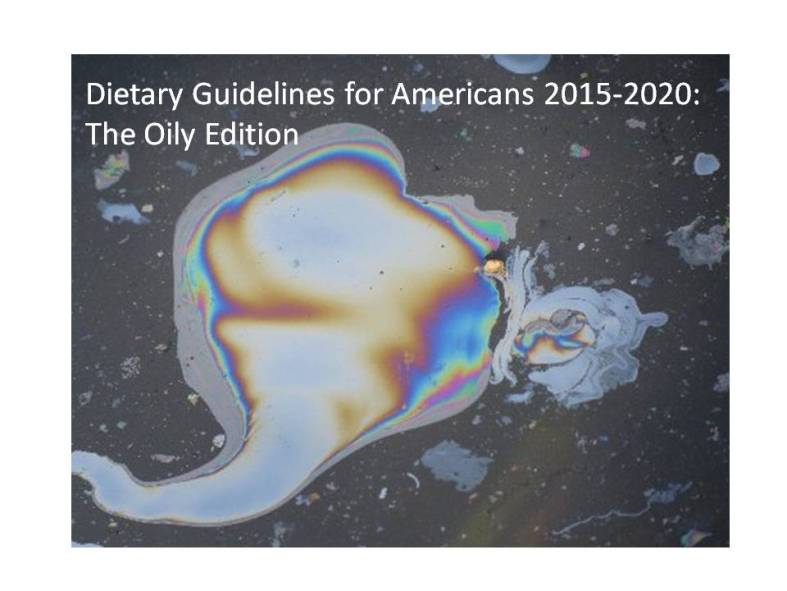I don’t say this very often (or ever). I was wrong. I think.
Here I’ve been laboring under the assumption that the 2015 Dietary Guidelines tell the American public to eat a diet lower in fat (because we eat “too much” of it now) and higher in carbohydrate (especially from whole grains like whole wheat–because we don’t eat “enough” of those now), to eat less salt, and to “eat as little dietary cholesterol as possible.” But according to a document recently released from a source at the Center for Nutrition Policy and Promotion (CNPP) that isn’t what the Guidelines say. Or at least not exactly. Maybe.
The good folks at CNPP were asked to respond to Kris Gunnar’s list of “20 Mainstream Nutrition Myths (Debunked by Science)” with the idea being that the Guidelines are about as “mainstream” as nutrition advice gets. The hope was that, if the good folks at CNPP could explain why their advice is ostensibly “backed by science” and yet is “debunked by science,” we would all sleep a little better at night, even if we still insisted on eating bacon and eggs in the morning.
The good folks at CNPP rose to the challenge and cleared things right up. But, to quote the inimitable if soporific Crosby, Stills and Nash, “just beneath the surface of the mud, there’s more mud. Surprise.”
Below, I’ve restated their responses as dietary guidance arranged in an order that I found amusing. The number of the corresponding “Myth” from Kris Gunnars is given as well, so that those of you with split screens or dual monitors can play along at home.
According to the good folks at CNPP, the 2015 Dietary Guidelines for Americans:
- do not recommend Americans eat a diet low in total fats or high in carbohydrates, particularly from grains. (Myth 1)
- do not encourage eating low-fat foods. (Myth 12)
- do not suggest avoiding saturated fat.(Myth 16)1
- do not say saturated fat raises LDL cholesterol. (Myth 6)2
- do not suggest Americans should avoid egg yolks, nor do they suggest that dietary cholesterol is linked to heart disease. (Myth 4)3
- do not suggest eating red meat raises risk of disease. (Myth 13)4
- do not say seed and vegetable oils lower cholesterol levels. (Myth 20)5
- do not recommend the population restrict sodium intake (Myth 2)6
- acknowledge there may be more to weight management and diet-related diseases than calories in-calories out. (Myth 15) 7
- do not state sugar is harmful. (Myth 19)8
I know what you’re thinking. Adele’s mind has finally blown a gasket from reading all those big words they have in grad school. I’m not going to argue that point, but you can check the CNPP’s response for yourself right here.
This response also acknowledges that current scientific evidence regarding the reduction of full-fat dairy is contradictory (Myth 10) and that a variety of eating patterns can produce weight loss (Myth 8). It also says that 3-5 cups of coffee a day can be part of a healthy diet (Myth 7)–hallafreakinlujah– but whole wheat products? Meh (Myth 5).
I can see the helpful public health messages now:
You should not avoid egg yolks, but you should eat as little dietary cholesterol as possible, even though dietary cholesterol consumption is not linked to heart disease.
You don’t need to choose low-fat foods, just choose fat-free or low-fat milk, yogurt, and cheese even though it might not actually help you avoid chronic disease .
You should shift to lower sodium consumption without restricting your intake of sodium.
What’s going on here?
Good question. Perhaps the good folks at CNPP didn’t actually read the Dietary Guidelines this time around. Who, except for me, has that kind of time? Or maybe they had a hard time finding them. Once you get to the health.gov/dietaryguidelines/ site, you have to click through 3 menus or links before you get to the actual guidelines (try it), which are a swarm of footnotes and “see more” hyperlinks. Even Marion Nestle complained about how hard all those “annoying drop-down boxes” are to navigate. It’s possible the good folks at CNPP just assumed that the other good folks over at DHHS–responsible for Guidelines online labyrinth–were paying attention so they didn’t have to.
Or maybe it means that it’s actually really hard to get words to say what you want them to say without them saying other things that you don’t want them to say. And this is especially difficult when you are asked to make sweeping recommendations based on a weak scientific evidence base that both supports and contradicts past guidance, which you can’t contradict even when you can’t support it, because, then what?
No wonder the good folks at CNPP are having a hard time getting their story straight.
To tell the truth, I have a lot of sympathy for the message-makers there at the USDA. We created the Dietary Guidelines 35 years ago assuming zero potential negative consequences. True, the scientific evidence didn’t strongly support the recommendations, but whatever. Whether they followed the recommendations or not, hey, the health trajectory of Americans couldn’t get any worse, could it? We knew the Guidelines would significantly impact the food industry, but that could only be a good thing, right? And we meant for Guidelines to set the direction for nutrition research, but since science is only about facts and never about politics or funding, any errors or biases in our original rationale would be quickly discovered and corrected, no?
Now it seems pretty clear that we might have spent a little more time thinking through the whole “Let’s make sweeping dietary recommendations that are meant to apply to every single American alive over the age of 2 as a method of preventing every single major chronic disease known to humankind “ thing before shrugging our shoulders and saying “Oh, no worries. It will all work out.” Now the folks at the USDA have used up their wishes and are left trying to stuff the genie back in the bottle with nothing but semantics and poor website design.
Will the real Dietary Guidelines please stand up?
If only they had a leg to stand on.
***************************************************************************
1. They just want you to reduce your intake of saturated fat without actually avoiding it.
2. They do recommend limiting saturated fats based on the notion that somehow this will reduce risk of heart disease. But let’s leave LDL cholesterol levels out of this. What did they ever do to you?
3. But Americans still should eat as little dietary cholesterol as possible, just fyi.
4. Eating red meat does not raise risk of disease, but not eating red meat lowers it. Um. Weird, right?
5. But you should eat vegetable oils instead of animal fats, because, well, because.
6. They do want you to shift to lower sodium consumption, just not by restricting your intake.
7. Although they remain singularly obsessed with calories in and out, there’s apparently no need for you to be.
8. But you shouldn’t eat very much of it anyway, because, well, because.


